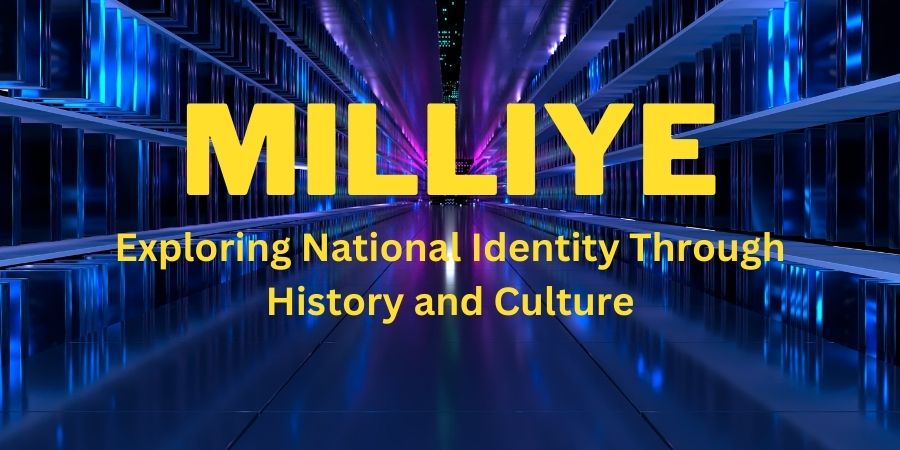
Milliye: Exploring National Identity Through History and Culture
The concept of “Milliye” encapsulates more than mere patriotism; it embodies a profound sense of national identity deeply rooted in history and culture. From its origins in Ottoman history to its role in shaping modern Turkey, “Milliye” has been a driving force behind societal movements and political ideologies. In this blog, we embark on a journey to unravel the layers of “Milliye,” exploring its historical significance, contemporary manifestations, and global implications. By delving into the essence of “Milliye,” we aim to provoke thought, spark curiosity, and shed light on the intricate interplay between identity, heritage, and belonging in today’s ever-evolving world. Join us as we delve into the heart of “Milliye” and uncover its enduring relevance in shaping our collective consciousness.
Understanding “Milliye”
The term “Milliye” is significant in the Turkish lexicon, representing far more than just a simple word. Its roots run deep, intertwining with the very fabric of Turkish history, culture, and identity. To truly grasp its essence, we must first delve into its etymology and linguistic origins.
1. Etymology and Linguistic Roots:
The word “Milliye” derives from the Arabic root “millah,” which translates to “nation” or “community.” In the context of Turkish culture, “Milliye” encompasses a collective sense of belonging and solidarity among the people, transcending geographical boundaries and political affiliations.
2. Evolution of the Concept Over Time:
Throughout history, the concept of “Milliye” has evolved in tandem with the socio-political landscape of Turkey. From its early manifestations in the Ottoman Empire, where it denoted loyalty to the Sultan and the state, to its pivotal role in the Turkish War of Independence led by Mustafa Kemal Atatürk, “Milliye” has adapted and transformed in response to changing circumstances.
3. Cultural and Historical Context:
To understand “Milliye” fully, we must contextualize it within the broader framework of Turkish culture and history. It is intrinsically linked to notions of patriotism, sacrifice, and resilience, as exemplified by the heroic acts of the Turkish people during times of adversity. Whether defending their homeland against foreign invaders or standing up for their rights in the face of oppression, the spirit of “Milliye” has remained a constant beacon of strength and unity for the Turkish nation.
Historical Significance
The historical significance of “Milliye” spans centuries, deeply entrenched in the annals of Turkish history and pivotal moments of national struggle. To appreciate its profound impact, we must examine its emergence during various epochs and its role in shaping the destiny of the Turkish nation.
1. Emergence During Ottoman History:
The roots of “Milliye” can be traced back to the Ottoman Empire, where it initially denoted allegiance to the Sultan and the state. During this period, the concept of “Milliye” was intertwined with notions of loyalty, duty, and honor, as Ottoman subjects rallied around the banner of Islam and the empire’s territorial sovereignty.
2. Role of “Milliye” in the Turkish War of Independence:
The true significance of “Milliye” became evident during the tumultuous years following World War I, as Mustafa Kemal Atatürk led a nationwide struggle for independence against foreign occupation forces. In this context, “Milliye” took on a new meaning, representing the collective will of the Turkish people to defend their homeland and preserve their national identity against external threats.
3. Legacy of “Milliye” in Modern Turkey:
The legacy of “Milliye” looms large in the modern Turkish state, serving as a foundational pillar of national identity and pride. From the establishment of the Republic of Turkey in 1923 to the present day, the spirit of “Milliye” continues to inspire and unite Turks from all walks of life, transcending differences of region, ethnicity, and ideology.
“Milliye” in Contemporary Context
In the contemporary landscape, the concept of “Milliye” continues to resonate deeply within Turkish society, manifesting itself in various cultural, political, and social spheres. To grasp its significance in modern times, we must explore its multifaceted expressions and implications.
1. Cultural Expressions and Symbols:
“Milliye” finds expression in a myriad of cultural symbols and practices that serve to reinforce national identity and pride. From traditional folk dances and music to national holidays and ceremonies, the spirit of “Milliye” permeates every aspect of Turkish culture, fostering a sense of unity and belonging among its people.
2. Political and Societal Implications:
In the realm of politics and society, “Milliye” often serves as a rallying cry for national unity and solidarity, particularly in times of crisis or conflict. Whether in the face of external threats or internal challenges, the concept of “Milliye” mobilizes the Turkish people to stand together in defense of their homeland and shared values.
3. Challenges and Debates Surrounding National Identity:
Despite its enduring significance, “Milliye” is not without its controversies and debates. In an increasingly globalized world, where identities are constantly evolving and boundaries are becoming more fluid, questions arise about the relevance and inclusivity of national identity. Some argue that an overly narrow conception of “Milliye” can lead to exclusionary practices and marginalization of minority groups, while others maintain that a strong sense of national identity is essential for maintaining social cohesion and resilience in the face of external pressures.
The Intersection of “Milliye” and Globalization
In an increasingly interconnected world shaped by globalization, the concept of “Milliye” intersects with broader global trends and dynamics, posing both opportunities and challenges for Turkish national identity.
1. Impact of Globalization on National Identity:
Globalization has ushered in an era of unprecedented connectivity and exchange, blurring the boundaries between nations and cultures. In this context, the notion of “Milliye” must contend with the forces of globalization, which promote cosmopolitanism and multiculturalism as alternative forms of identity. While globalization offers the potential for greater diversity and openness, it also raises concerns about the erosion of traditional values and the dilution of national identity.
2. Responses to Global Challenges While Preserving National Identity:
In response to the challenges posed by globalization, Turkish society has sought to reaffirm its national identity while engaging with the wider world. Efforts to preserve cultural heritage, promote national pride, and assert sovereignty over shared historical narratives serve as a means of safeguarding the integrity of “Milliye” in the face of external pressures. At the same time, initiatives to embrace diversity, foster dialogue, and engage with global issues reflect a willingness to adapt to changing realities without compromising core values.
“Milliye” in Arts and Literature
In the realm of arts and literature, “Milliye” serves as a rich source of inspiration and exploration, shaping narratives, imagery, and cultural expressions that reflect the essence of Turkish national identity.
1. Representation in Literature, Film, and Art:
Throughout history, Turkish artists, writers, and filmmakers have drawn upon the themes of “Milliye” to create works that capture the spirit of national pride and resilience. From epic poems and novels that recount tales of heroism and sacrifice to cinematic masterpieces that celebrate the struggle for independence, “Milliye” has provided fertile ground for artistic expression and interpretation. Likewise, visual artists have depicted scenes of patriotism, unity, and solidarity in their paintings, sculptures, and installations, invoking the imagery of “Milliye” to evoke emotions of pride and belonging among viewers.
2. Role of Artists and Writers in Shaping National Consciousness:
Beyond mere representation, artists and writers play a critical role in shaping national consciousness and identity through their creative endeavors. By portraying the values and ideals of “Milliye” in their works, they contribute to the preservation and propagation of Turkish cultural heritage, fostering a sense of shared history and destiny among the Turkish people. Through their artistry and imagination, they inspire future generations to embrace the legacy of “Milliye” and carry it forward into the future.
Looking Forward: The Future of “Milliye”
As we gaze into the future, it becomes imperative to consider the evolving dynamics and challenges that will shape the trajectory of “Milliye” in the years to come. While rooted in history and tradition, the concept of “Milliye” must adapt to the changing realities of the modern world, navigating a complex landscape of globalization, technological innovation, and shifting societal norms.
1. Prospects for National Identity in the Digital Age:
In an era defined by digital connectivity and virtual communities, the concept of national identity is undergoing a profound transformation. The internet and social media platforms provide unprecedented opportunities for global exchange and interaction, challenging traditional notions of belonging and allegiance. As such, the future of “Milliye” will likely be influenced by the extent to which it can harness digital technologies to foster a sense of community and solidarity among Turks both at home and abroad.
2. Potential Challenges and Opportunities:
While globalization presents opportunities for greater connectivity and cultural exchange, it also poses challenges to the preservation of national identity. As Turkish society becomes increasingly diverse and interconnected, the concept of “Milliye” may face scrutiny and criticism from those who advocate for a more inclusive and pluralistic approach to identity. However, these challenges also present opportunities for dialogue, reflection, and adaptation, as Turks seek to redefine what it means to be part of a globalized world while remaining true to their cultural heritage and values.
Strategies for Sustaining and Nurturing National Identity: In order to sustain and nurture the spirit of “Milliye” in the face of these challenges, it will be essential to promote education, dialogue, and engagement among Turks of all backgrounds. By fostering a sense of shared history, values, and aspirations, Turkish society can strengthen its collective identity and resilience, ensuring that the legacy of “Milliye” endures for generations to come. Additionally, embracing diversity, fostering intercultural understanding, and promoting civic engagement are critical strategies for building a more inclusive and cohesive society that reflects the principles of “Milliye” in action.
Conclusion
The exploration of “Milliye” has unveiled its multifaceted significance in shaping Turkish national identity throughout history and into the modern era. From its origins in Ottoman history to its enduring legacy in contemporary Turkish society, “Milliye” embodies the spirit of unity, resilience, and pride that binds the Turkish people together. As we have delved into its etymology, historical significance, cultural expressions, and future prospects, it becomes clear that “Milliye” transcends mere patriotism—it represents a collective consciousness and shared heritage that continues to inspire and empower Turks across generations. Moving forward, the challenges and opportunities presented by globalization and the digital age call for a renewed commitment to preserving and nurturing the essence of “Milliye” while embracing the diversity and dynamism of the modern world. By doing so, Turkish society can forge a path towards a future that honors the legacy of “Milliye” while embracing progress, inclusivity, and resilience.


